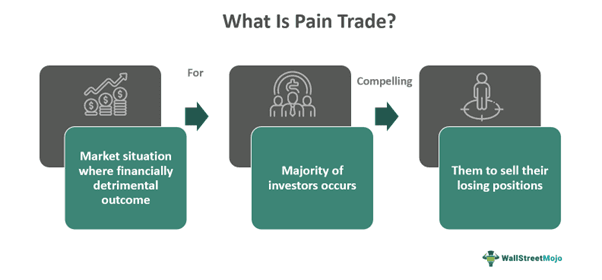Table of Contents
Pain Trade Meaning
Pain trade in financial markets describes a scenario where the majority of investors are positioned towards a specific market trend, only for the market to move in the opposite direction, causing financial losses and "pain" to those investors. This concept is used to analyze and understand market behavior, especially during unpredictable trends.

The pain trade highlights the importance of portfolio diversification, encouraging investors to spread their investments to mitigate risk and avoid significant losses from unexpected market movements. It also increases anxiety and fear among investors, as shifts in asset allocation and short-covering activities can lead to increased market volatility and a fear of missing out (FOMO) on potential gains.
Key Takeaways
- Pain trade in a financial markets market means a situation in which most investors align their positions with a particular trend but suffer when that trend reverses, hurting them.
- It has aided in the comprehension and analysis of market behavior amid erratic market patterns.
- It occurs when the majority of market participants deploy the same trading strategy, resulting in sudden reversals, sudden price increases, unrealistic returns, high risks, consensus, and lack of transparency.
- It can be avoided by - enduring short-term losses, trusting long-term US securities, stopping herding, claiming early winnings, and using a long-term investment strategy.
Pain Trade Explained
Pain trade refers to a market phenomenon where the majority of investors suffer significant losses due to unexpected market movements. It typically occurs in the short term when a popular asset class, trade, or market trend moves opposite to the anticipated direction of the strategy employed by the majority of investors. This phenomenon often happens when investors follow the prevailing consensus or heavily crowded positioning, and a sudden market reversal catches them off-guard. Consequently, the market causes considerable pain to these investors, potentially leading to a cascading effect as traders are forced to exit their positions.
Several factors contribute to the pain trade, including market sentiment and psychology, shifts in market conditions, and leverage and positioning. A typical pattern in markets is that when most investors hold a bearish outlook, stock prices may climb, and vice versa. This highlights the importance of understanding market sentiment, its impact on investment planning, and the need for portfolio diversification.
Understanding the dynamics of the pain trade can help intelligent traders position themselves for lower risks and higher opportunities. It emphasizes the significance of combining technical and fundamental analysis to navigate market movements effectively. However, the pain trade can have widespread adverse effects on the financial sector, leading to significant losses and emotional stress for traders caught in market reversals. This stress can sometimes result in traders holding onto losing positions longer than they should, exacerbating their losses.
Many traders use Saxo Bank International to research and invest in stocks across different markets. Its features like SAXO Stocks offer access to a wide range of global equities for investors.
Causes
There can be many causes for such trading, as listed below:
- It happens when the same trading strategy has been used by a vast number of market participants, making the market prone to sudden reversals.
- A popular asset sector or class goes through a sudden price rise followed by a steep price decline, leading to widespread losses.
- Investors get caught on their guard when they invest considerable amounts in overpaying assets, hoping for unrealistic returns.
- Investors tend to take high risks or take a lot of leverage, and then, at times, when the market turns its tide against them, they suffer significant losses.
- Changes in market trends or economic conditions promote consensus amongst a large number of investors, resulting in significant and sudden price movements.
- Market participants go through pain points due to a need for more transparency or consistent data in post-trade markets.
Examples
Let us understand the topic using a few examples.
Example #1
An online article published on June 7, 2023, discusses the pain trade phenomenon experienced by traders. It explains the dilemma traders face, having to choose between chasing tech stock yields, which led to a 33% surge in the Nasdaq 100 in 2023, or staying out of the market and missing out on gains. According to Etoro's Ben Laidler, the most significant risk has been getting out of the market. Despite the threats of a looming US recession, tech stocks have been dominating the market as investors focus more on interest rates rather than macroeconomic conditions.
Cautious investors are advised to seek refuge in stable banks and high-yield European credit. The article underscores the concept of the pain trade, highlighting how it influences traders' daily investment decisions by emphasizing the risks associated with both participating in and abstaining from the market.
Example #2
Let us assume that in the country of Old York, there exists a renowned financial company called Alpha Investments, with Professor Adam as its CEO. The company's stock experiences exponential growth, with its stock prices soaring. Investors X, Y, and Z, along with expert investor Johnny, invested heavily in Alpha Investments, hoping to achieve continuous gains. However, a sudden shift driven by key personalities surprised the market.
The Federal Reserve maintained its stance, supporting a resilient market and focusing on big technology and defensive growth sectors. Nevertheless, a significant pain trade began due to bearish sentiments, leading to an exit from US equity funds and a plummet in Alpha Investments' stock price.
How To Avoid?
For traders, it has become essential to avoid trading at pain by following the below means:
- Try to endure at least a 20-30% dip instead of losing out on future profits by not getting discouraged from short-term losses.
- Place trust in large-cap US securities' long-term prospects, which have delivered regular returns historically.
- Stop herding with the majority of investors having conventional ideas on investment to eliminate any unexpected volatility.
- One must claim profits from their early winning idea to reduce profits.
- One must remain long-term invested so as to stay underinvested.
- A long-term investment strategy has to be utilized to turn temporary trading pain into long-term gains.
Disclosure: This article contains affiliate links. If you sign up through these links, we may earn a small commission at no extra cost to you.

